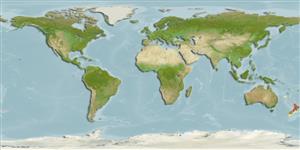Lớp phụ Cá sụn (cá mập và cá đuối) (sharks and rays) >
Myliobatiformes (Stingrays) >
Myliobatidae (Eagle and manta rays)
Etymology: Myliobatis: Greek, mylo = mill + Greek, + Greek, batis,-idos = a ray (Raja sp.) (Ref. 45335).
Environment: milieu / climate zone / depth range / distribution range
Sinh thái học
Biển; Thuộc về nước lợ Sống nổi và đáy; Mức độ sâu 0 - 160 m (Ref. 26346). Temperate
Southwest Pacific: Norfolk Island and New Zealand, including the Kermadec Islands.
Bộ gần gũi / Khối lượng (Trọng lượng) / Age
Maturity: Lm ? range ? - ? cm
Max length : 150 cm WD con đực/không giới tính; (Ref. 12951); common length : 100.0 cm TL con đực/không giới tính; (Ref. 9258)
Short description
Khóa để định loại | Hình thái học | Sinh trắc học
Olive-green, yellow or dark brown dorsally with pale blue or grey markings; white ventrally (Ref. 26346). No caudal fin (Ref. 26346).
Occurs in bays, estuaries, and near rocky reefs (Ref. 12951). Usually solitary (Ref. 12951). Feeds on clams, oysters, worms, and crabs (Ref. 12951). Ovoviviparous (Ref. 50449). Although the spine on the tail is capable of inflicting a painful wound, the poison is quickly neutralized by immersion of the injured area in hot water (Ref. 26346).
Life cycle and mating behavior
Chín muồi sinh dục | Sự tái sinh sản | Đẻ trứng | Các trứng | Sự sinh sản | Ấu trùng
Exhibit ovoviparity (aplacental viviparity), with embryos feeding initially on yolk, then receiving additional nourishment from the mother by indirect absorption of uterine fluid enriched with mucus, fat or protein through specialised structures (Ref. 50449). Young are born at less than 50 cm (Ref. 26346).
Francis, M.P., 1993. Checklist of the coastal fishes of Lord Howe, Norfolk, and Kermadec Islands, Southwest Pacific Ocean. Pac. Sci. 47(2):136-170. (Ref. 8879)
IUCN Red List Status (Ref. 130435: Version 2024-1)
Human uses
Các nghề cá: buôn bán nhỏ
Các công cụ
Special reports
Download XML
Các nguồn internet
Estimates based on models
Preferred temperature (Ref.
123201): 14.4 - 19.8, mean 16.6 °C (based on 74 cells).
Phylogenetic diversity index (Ref.
82804): PD
50 = 0.5002 [Uniqueness, from 0.5 = low to 2.0 = high].
Bayesian length-weight: a=0.00389 (0.00119 - 0.01269), b=3.08 (2.83 - 3.33), in cm total length, based on LWR estimates for this (Sub)family-body shape (Ref.
93245).
Mức dinh dưỡng (Ref.
69278): 3.5 ±0.4 se; based on size and trophs of closest relatives
Thích nghi nhanh (Ref.
120179): thấp, thời gian nhân đôi của chủng quần tối thiểu là 4.5 - 14 năm (Fec assumed to be <100).
Fishing Vulnerability (Ref.
59153): Very high vulnerability (83 of 100).
Nutrients (Ref.
124155): Calcium = 3.64 [0.51, 61.12] mg/100g; Iron = 0.186 [0.018, 2.244] mg/100g; Protein = 19.8 [14.5, 25.0] %; Omega3 = 0.327 [0.095, 0.951] g/100g; Selenium = 14.3 [2.7, 79.6] μg/100g; VitaminA = 4.82 [0.41, 52.01] μg/100g; Zinc = 0.407 [0.030, 4.511] mg/100g (wet weight);
